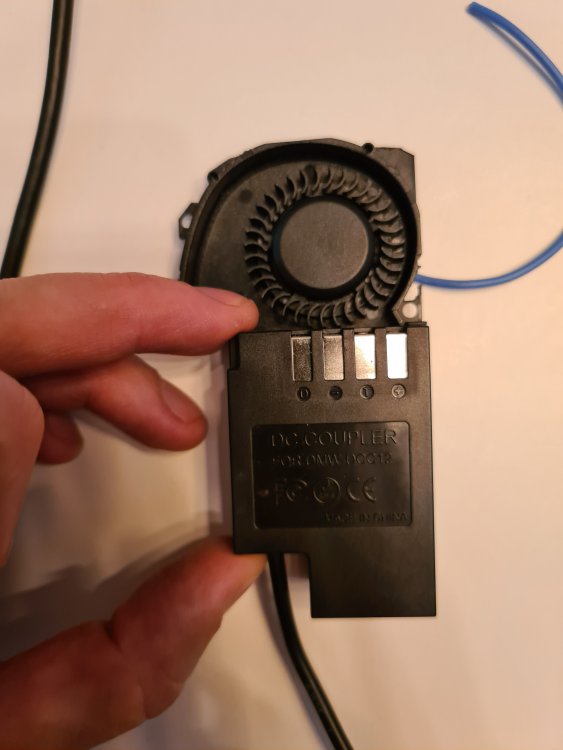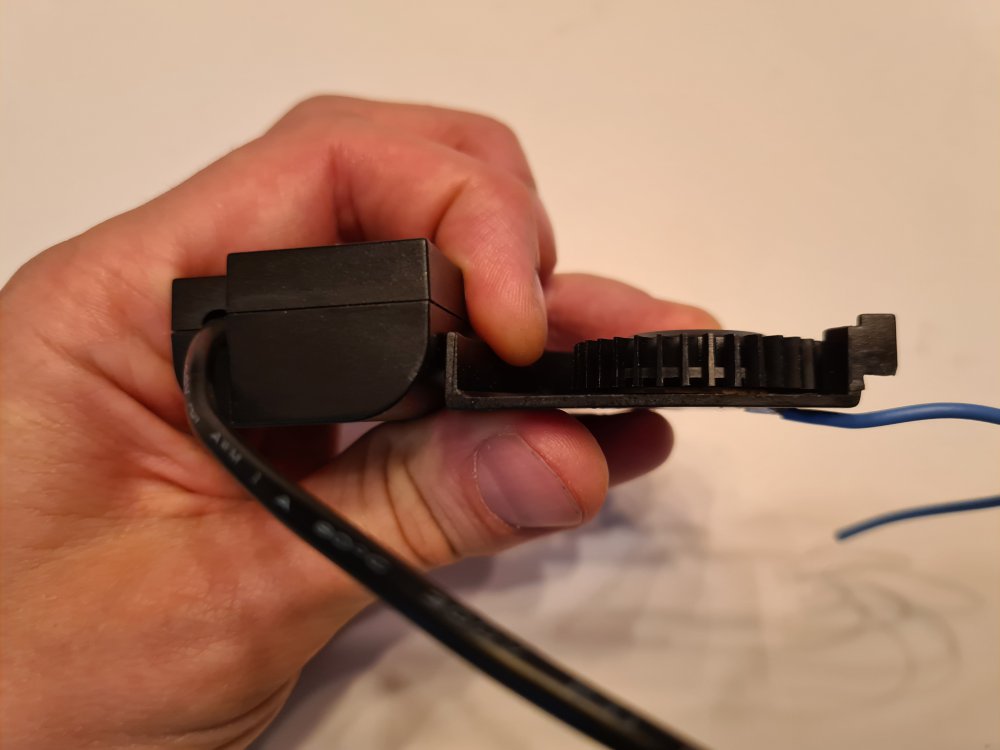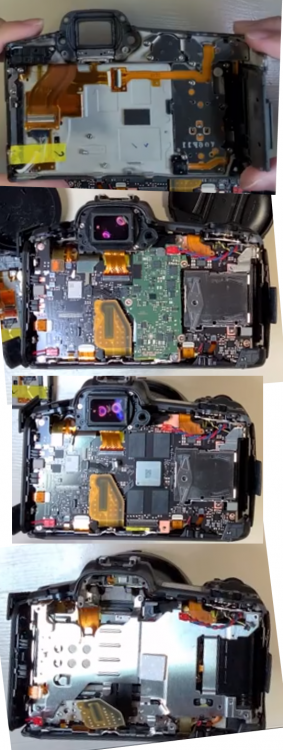
UncleBobsPhotography
Members-
Posts
332 -
Joined
-
Last visited
Content Type
Profiles
Forums
Articles
Everything posted by UncleBobsPhotography
-
How to better diffuse those compact LED lights?
UncleBobsPhotography replied to Amazeballs's topic in Cameras
As the post above mentioned, I have found umbrellas to be the most portable softening method (either reflecting or diffusing). However, I am questioning whether a small LED like that will have enough power to be used with a reflector. The problem with the clip-on diffusers is that they are so small that you might as well just get a slightly larger LED panel and not have to deal with the hassle. The lightest way to get soft light would be to use a ring-light, just be wary of the distinct pupil reflections and somewhat unnatural look if you don't have an additional keylight. -
I don't see any reason to use it for photography on M43 when I have a full frame Canon body to use it on. As much as I love my GH5, I don't use it for photography because I'm always disappointed when I compare it to full frame. I tried it just now with the Viltrox non-speedbooster, but even if the manual focus was more usable, it's simply too noisy. I have several 50mm lenses with manual focus/focus clutch I would rather adapt for video.
-
Not safe to power monitor and camera from same power source?
UncleBobsPhotography replied to Jeremy Clark's topic in Cameras
The case which is linked to powered both cameras from the same V-lock battery. My monitor came with a dummy battery for powering my camera from the monitor (SWIT). I hope this is a sign that the they have thought of the problem and found a solution for it. Does anyone have any examples of the monitor frying the HDMI even when it was made for powering the camera? -
I use the 17 f1.2 a lot. The lens is great and I love the manual focus. The only thing that bugs me is that my Canon 40mm f2.8 is 1/3 of the weight, 1/6 of the price, is sharper, and gives me pretty much the same field/depth of view on a full frame Canon. It doesn't take away the fact that the Olympus on my GH5 currently gives me the best video quality I'm able to produce, but makes me hesitant to buy more Olympus lenses since I've got the R5 ordered. Sources: https://www.opticallimits.com/m43/1082-olympus17f12 https://www.opticallimits.com/canon_eos_ff/752-canon_40_28_ff
-
Do you mean you hear yourself in your headphones when you use the mic? I have this situation in Premiere (probably just a setting) but not when I use it in Teams/Zoom. One odd thing is that the mic seems to ignore the physical volume control when used as a USB microphone, so I guess it adjust the levels automatically?
-
Good points. I've heard reports that watching a HDR uploaded video on a non-HDR display will look worse than watching a video which was graded for non-HDR in the first place, which makes it a bit pointless since most viewers most likely will not watch it on an HDR display anyway. I've noticed more and more YouTubers using 1080p60, and usually it looks pretty good. If your primary audience is YouTube, then shooting in 60p might be a good idea. Personally I wouldn't upload in 50/60p unless I shot it in 50/60p. One advantage of upping the frame-rate over the resolution is that YouTube will default it to 60p, while it will very seldom default to 1440p or 4k. Then there is of course the artistic choice of whether 24p, 30p or 60p looks better, but that's a whole other discussion.
-
Uploading to YouTube is all about getting YouTube to give you more bandwidth. High resolution, high framerate and high dynamic range all seem to give your file higher bitrate. VR (denoted by an s instead of p like 1440s) also give significantly higher bitrate, but is of course not suitable for all productions. I haven't done any precise testing on how much impact each factor has.
-
I use the VideoMic NTG pretty much every day. It's just soooo convenient. Plug it in via USB and you have a perfect computer microphone. When you are using it via 3.5mm it turns on/off automatically, and whenever i mess up the levels, the safety track has got me covered. The noise floor might not be best in class, but those quality of life features have saved me several times
-
How many money I need to buy a camera with those characteristics?
UncleBobsPhotography replied to Dan Wake's topic in Cameras
You need to prioritize. You can't have everything. It seems like your understanding of cameras is not that great, and in that case I would put off investing too much in cameras until you understand what you actually need. If you really need to get close to a subject while it's pitch dark, you should get a lens with a shorter zoom range and larger aperture. Learning how to use noise reduction properly is also much more affordable than quadrupling your ISO performance. An all-in-one 1" camera and putting the rest of your budget into sound equipment might be good. This is not at all what you asked for, but it might serve you well. -
Development Update - AFX Focus Module For PBC
UncleBobsPhotography replied to BTM_Pix's topic in Cameras
Very impressive. I assume the ToF sensor measure the distance straight ahead? Is it feasible to adjust the focus point position? I guess turning the unit would not give accurate results with a flat focus plane. Excuse my ignorance if I don't understand how it works. -
Propably with a hefty participation fee. The cynic in me has started to believe that most awards are scams/heavily biased. How can the camera of the year not win best APS-C when it happenes to be an APS-C camera? I guess no camera is allowed to win more than 1 category?
-
Are you using the actual "Media player classic"? https://sourceforge.net/projects/mpc-hc/ It's odd how a 5 year old media player is the most suitable one for running these "new" formats.
-
EOSHD testing finds Canon EOS R5 overheating to be fake
UncleBobsPhotography replied to Andrew - EOSHD's topic in Cameras
This might be obvious, but this is rather easy to figure out. 2 ways: 1) Use a dummy battery and attach an amperemeter 2) Avoid overheating by putting the camera in a freezer and count how much you can record on a full battery -
EOSHD testing finds Canon EOS R5 overheating to be fake
UncleBobsPhotography replied to Andrew - EOSHD's topic in Cameras
He got problems when he turned the screen on. I wonder how internal recording works with the screen off using an external monitor. To be honest, I'm just jealous my order isn't arriving any time soon so I can do my own testing. -
I bought a Canon EOS R5 - potential overheating solutions
UncleBobsPhotography replied to Andrew - EOSHD's topic in Cameras
Assuming the R5 does in fact overheat and that additional cooling is beneficial, I just thought of a fan-placement I haven't seen before (perhaps with good reason). I usually use a dummy battery because I prefer to use LP-F batteries. A radial fan would actually fit inside the dummy battery. Cutting down on the left size of the exhaust might degrade the performance somewhat, but it should still work.. It is also half the height of the dummy battery (picture 2), which makes it possible to make half the height for exhaust and half for intake. The dummy battery already has 7.4v, hooking up a 12 V fan gives a nice breeze without much noise. It might be too noisy for the internal microphones, but is silent >10 cm away. This is not the hottest place on the camera, but any cooling is better than no cooling and the advantage of this over other cooling methods is that it would have zero impact on the ergonomics of the camera for anyone who is already using a dummy battery. To make this work, the dummy battery should have the casing removed in the direction it's supplying the main cooling. Alternatively it could be open on both wide sides but have barrier in the middle to separate the intake and the exhaust, giving it the shape on an H pillar. Sorry for the oversized images, I couldn't figure out how to resize it. -
The Z-Cam E2 does seem to have all the technical specs I need, but of course I will find something to complain about. The width of the camera is 91 mm which is on the high end (but probably usable) "interpupilar" distance. The black magic studio camera would be 82mm in normal orientation or 66mm in vertical position. With a camera 91 mm wide, the distance from the camera to the nearest subject has to be greater. The Z-Cam K1 solve this problem completely, but the picture quality is worse and it has very little flexibility. But I agree, the Z-Cam E2 is the most suitable solution I have found so far. So far I've used dual-GH5 vertically, which has worked pretty good, so my plan has been to wait for the next generation of cameras before making a proper VR-rig.
-
I am working on building a new VR camera-rig, and it seems like this would actually solve some of my problems, but has a lot of functionality I have no use for (switching). To get sufficient quality for VR, two high quality synchronized video recordings are necessary. With the ability to switch the recorded 1080p with the raw files, the ATEM Mini Pro ISO should solve that problem well. So far I've had to start the two cameras individually and "synchronize" them in post, which adds a lot of complexity. However, since I have no use for the whole switcher board, which is the main feature of the ATEM, I ask: Is there any other reasonable products that can record two 4k cameras at the same time? I know that the Atomos Shogun 7 can record 4 signals at the same time, but only in HD, which is not sufficient. My ideal setup would be to have two cameras the size of the Blackmagic Micro Studio Camera 4K connected to a small screen like the Ninja V or Shogun 7 and be able to get genlocked 4k60p only by operating the screen. Are there any other recorders I should look at? I am willing to make some compromises. I know the Z-Cam E2 has the genlock locked down, but would like more options.
-
I bought a Canon EOS R5 - potential overheating solutions
UncleBobsPhotography replied to Andrew - EOSHD's topic in Cameras
Regarding the most reason blog post, I wonder what would happen if you left the camera for 2 hours in the freezer, started recording and put it back in the freezer. With a starting temperature and ambient temperature of -18C, it should be able to run more than 20 minutes before overheating even with internal recording. If it stops at 20 it would be a clear indicator of a software limit. It might not be too tempting to do with a new camera, but it shouldn't be any worse than bringing a camera inside during the winter. -
I bought a Canon EOS R5 - potential overheating solutions
UncleBobsPhotography replied to Andrew - EOSHD's topic in Cameras
With how poor the heat design of this camera is, it should be pretty easy for them to create a fantastic cinema camera with the same sensor and internals but with a proper cooling system. From how the R5 looks it shouldn't even be necessary with fans as long as they use proper heat pipes and heat sinks. However, it doesn't seem like any of the new cameras, R200, R300, XF505 or XC20 is going for this approach, which makes me wonder what they are trying to protect. It should be noted that I was so impressed by their new technology (and the 40% drop in their stock price) that I bought Canon stocks a few days ago, which makes me a bit biased. Canon's problem has been that they haven't had the technology to keep up. Now they have a great photo camera (I believe the R5 will be good for photo but crippled for video), and the technology to release quality products the next few years. -
I bought a Canon EOS R5 - potential overheating solutions
UncleBobsPhotography replied to Andrew - EOSHD's topic in Cameras
I tried normalizing some cut outs from the video, flipping the back panel to make it easier to compare. There are 2 air gaps and one PCB board between the heat conductor covering the chips in picture 3 before it gets to the back panel. I am not sure what the white and black material in the first picture is. If the white material is a soft heat pad, then it would provide fair conductivity to the PCBs and eliminate one air gap. It could also just be the magnesium chassis. The black rectangle is placed right above the hot parts, could be a thermal pad. There seems to be one copper part on the top left under the wiring. This could mean the small white chip on the top left in the second picture also generate heat. The heat conductor in picture 4 seems to only distribute the heat around the internals of the camera, which means the heat will slowly reach the chassis after heating up the internals and conducting through the air gaps. This conductor has a thermal pad to the back of the PCB with the main chips (CPU?), but I would guess that the main purpose would be to redistribute heat from the image sensor since there is a large surface facing the sensor. However, because of the IBIS there is an air gap between the sensor and this heat conductor. Everything that generates heats except for the memory card is covered by PCBs, which makes it a lot more difficult to make any improvements. The easiest and maybe most promising DIY improvement would be to cover the parts with electrical insulating thermal paste. Silicon thermal paste is much worse than metal thermal paste from a thermal perspective, but should be safe to add anywhere as long as it doesn't get near the IBIS. It would make it a mess if you ever need to have the camera repaired. -
I bought a Canon EOS R5 - potential overheating solutions
UncleBobsPhotography replied to Andrew - EOSHD's topic in Cameras
Those thermal pads doesn't lead the heat anywhere... 🤔 The only real connection between the hot parts and the body seems to be around the screw holes, that's way too far for the heat to travel before reaching the chassis. -
Canon EOS R5 / R6 overheating discussion all in one place
UncleBobsPhotography replied to Andrew - EOSHD's topic in Cameras
Everybody here agrees that the R5 has overheating problems, but whether or not it's a deal breaker depends on the users usecase. For me, the R5 seems to offer something very useful and I have therefore ordered the camera fully aware of the overheating. It seems like this makes me a canboy from your point of view, and you seem to refuse to acknowledge that the R5 might work well for users with different needs than you. My last Canon camera is the 6D from 2012 and I own newer cameras from both Sony and Panasonic. The R5 will enable me to retire my Sony camera and 6D, while my GH5 will cover the the cases where the R5 falls short. -
Gerald Undone - EOS R5 & EOS R6 Excellent Review
UncleBobsPhotography replied to herein2020's topic in Cameras
To make it truly modular, it should be easy to use 3rd party solutions for each module. The way the GXR is modular is just a gimmick in my opinion. -
I guess the reason for this comment is because Jinny Tech released a new part yesterday? I have to admit there are a bit too many details in this case for me to really follow what's going on.
-
Gerald Undone - EOS R5 & EOS R6 Excellent Review
UncleBobsPhotography replied to herein2020's topic in Cameras
The 5DIV went on sale 25. august 2016. That's 6 short years. And by DR I assume you mean dynamic range in clog 1? Since this forum focuses on video it makes sense to mention the clog 1 DR, but tests have shown that the camera is capable of considerably better DR than previous Canon cameras in stills mode (and possibly Clog 3 in the future) and claiming that the R5 has no better DR than the 5DIV is taking things out of context. These kind of inaccurate statements makes it easy to ignore user completely even though he/she might have other valuable information.





